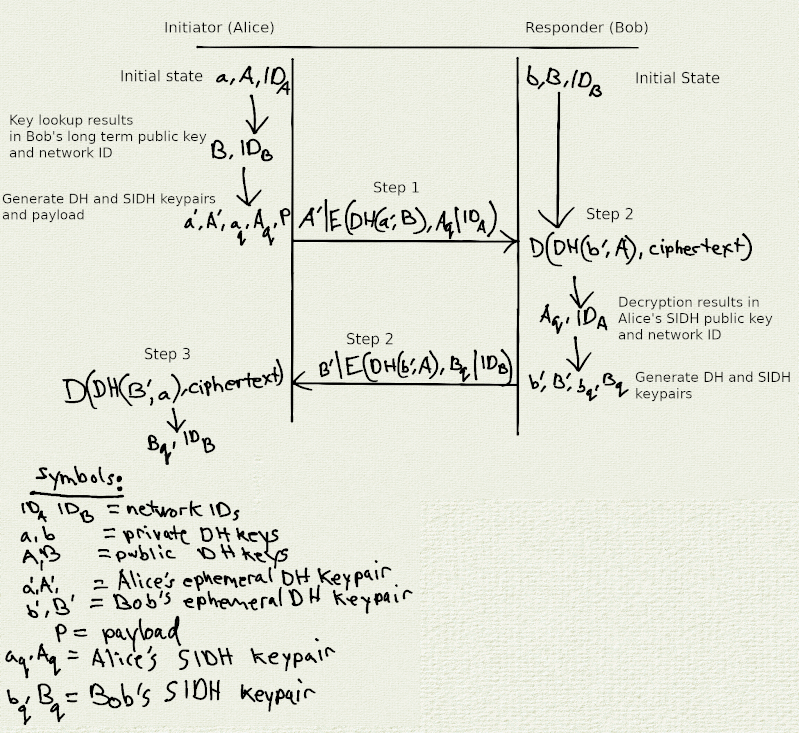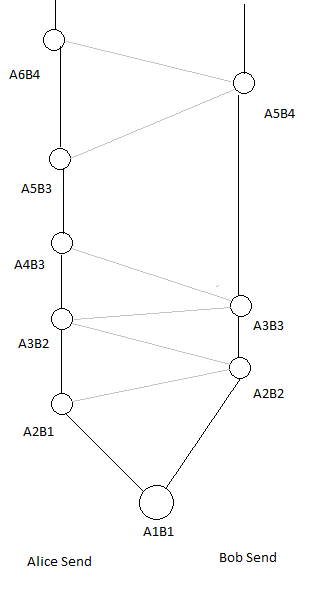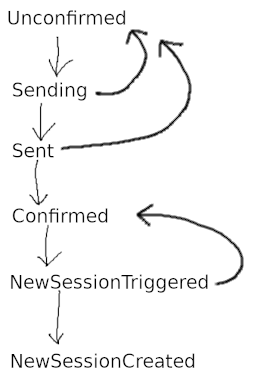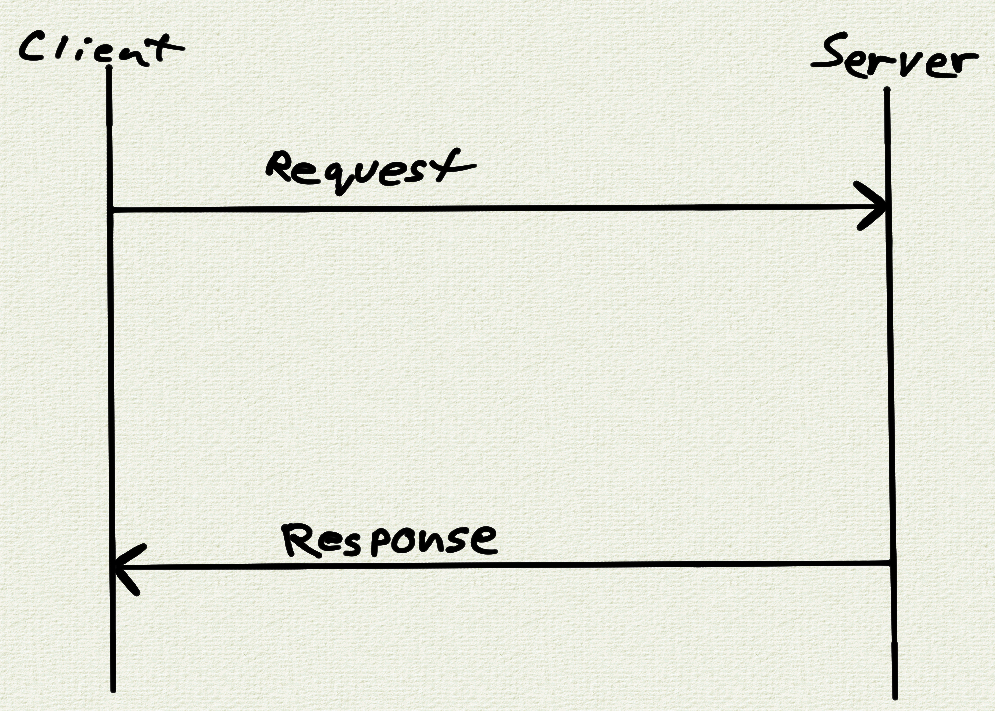End To End Cryptographic Protocol
Benjamin Wenger
Richard T. Carback III
David Stainton
Abstract
Here we discuss some design details of the end to end cryptographic protocols of the xx network chat application known as xx messenger.
Introduction
In addition to message confidentiality and authenticity we have the additional requirement of bitwise indistinguishability. Meaning that we don't want our end to end message ciphertexts leaking any bits of information that helps an adversary distinguish some kind of metadata.
Unlike common encrypted chat applications, here we cannot afford to exchange new keys with every message since the DH and SIDH keys take up most of the available payload in a cMix message. Therefore keys are exchanged less frequently than every message.
Cryptographic primitives
- XChaCha20: Length is 256 bits. Used for encrypting message payloads.
- Blake2b: Length is 256 bits. Used as part of key generation, key expansion, identity generation, and identification codes. Used to combine Diffie–Helman and SIDH keys after key integration.
- HMAC-SHA256: Length is 256 bits. Message HMACs.
- Diffie–Hellman: Length is 3072 bits. Discrete log-based component of key negotiation.
- SIDH: Length of public key is 3024 bits. Quantum resistant component of key negotiation.
In cMixx SIDH was later replaced by CSIDH
Auth Request Response Protocol
The Auth Request Response Protocol is similar a two way handshake with preshared keys whereas in this case only the sender has the longterm identity key and network ID of the other party. It should also be noted that the exchange is fully authenticated and is interactive; it requires explicit authorization of both parties. This protocol is used by xx messenger and is a prerequisite to it's establishing a secure communications channel between two clients. It can be initiated via client exchange of QR codes or by means of the user discovery protocol. Either way the exchange of both party's network IDs is a prerequisite.
An important property of this protocol is that it does not leak long term identity keys or network IDs. If it did leak such data then there would be no point in using a mix network to hide the identities of the communicating parties.
Pseudo Code Cryptographic Function Glossary
The following sections are populated with pseudo code examples which are used to explain sections of our cryptographic protocols. It is hoped that this glossary will help you understand the pseudo code.
-
|: byte concatenation
-
HMAC(key, data): HMAC uses the given key to compute an HMAC over the given data.
-
H(x): H is a cryptographic hash function.
-
DH(my_private_key, partner_public_key):
Diffiehellman function used to calculate a shared secret. -
ownership_proof(my_private_key, partner_public_key):
The ownership proof is simply the hash of a Diffiehellman shared secret and the ownership proof vector, defined as:H(DH(my_private_key, partner_public_key) | "ownershipVector")
Which is to say that "ownershipVector" vector is also hashed along with the Diffiehellman output.
-
E(key, payload): Stream-cipher encrypt payload.
-
D(key, payload): Stream-cipher decrypt payload.
-
Encrypt(key, payload): Encrypt and then MAC:
MAC(key, E(key, payload)) -
Decrypt(key, payload): MAC then Decrypt:
if MAC(key, payload) { // If MAC is valid...
D(key, payload)
}
High level Auth protocol description

Note: Since the SIDH keypairs are ephemeral encrypting the public SIDH keys isn't necessary but is done so at this time because it's an artifact of our implementation.
This is a two party protocol with a couple of assumptions:
- Each party has a long term Diffiehellman key pair and a network ID.
- The sender learns their partner's long term Diffiehellman public key and network ID by means of a QR code or by using the user discovery database.
Before anything is sent on the network, each party then generates the following:
- Ephemeral Diffiehellman key pair
- Ephemeral SIDH key pair
Let's work an example with Alice and Bob where Alice is the initiator who sends the Auth Request Message and Bob is the responder who replies with the Auth Response Message. Through the use of the xx network's User Discovery protocol Alice first learns Bob's long term DH public key and Network ID. Once Bob decrypts the Auth Request he receives from Alice, he learns Alice's network ID and can use this to retrieve Alice's long term DH public key and confirm the ownership proof she sends.
Alice's initial state contains:
- alice_network_id
- alice_longterm_dh_private_key
- alice_longterm_dh_public_key
- bob_network_id
- bob_longterm_dh_public_key
Bob's initial state contains:
- bob_network_id
- bob_longterm_dh_private_key
- bob_longterm_dh_public_key
- alice_network_id
- alice_longterm_dh_public_key
Protocol steps:
-
Alice generates some short term keys and then computes the Auth Request Message, denoted as alice_auth_request, and sends it to Bob:
Keys generated:
- short-term DH key pair:
- alice_ephemeral_dh_private_key
- alice_ephemeral_dh_public_key
- short-term SIDH key pair:
- alice_ephemeral_sidh_private_key
- alice_ephemeral_sidh_public_key
- payload:
- alice_payload
- short-term DH key pair:
symmetric_key = DH(alice_ephemeral_dh_private_key, bob_longterm_dh_public_key)
alice_ownership_proof = ownership_proof(alice_longterm_dh_private_key, bob_longterm_dh_public_key)
alice_auth_request = alice_ephemeral_dh_public_key |
Encrypt(symmetric_key, alice_ephemeral_sidh_public_key | alice_payload | alice_ownership_proof | alice_network_id)
- Bob receives alice_auth_request, decrypts it, generates some short term keys and computes a reply denoted as bob_auth_response, and sends it to Alice:
alice_ephemeral_sidh_public_key, alice_payload, alice_ownership_proof, alice_network_id
= Decrypt(DH(bob_longterm_dh_private_key, alice_ephemeral_dh_public_key), alice_auth_request)
Keys generated:
- short-term DH key pair:
- bob_ephemeral_dh_private_key
- bob_ephemeral_dh_public_key
- short-term SIDH key pair:
- bob_ephemeral_sidh_private_key
- bob_ephemeral_sidh_public_key
symmetric_key = DH(bob_ephemeral_dh_private_key, alice_longterm_dh_public_key)
bob_ownership_proof = ownership_proof(bob_longterm_dh_private_key, alice_longterm_dh_public_key)
bob_auth_response = bob_ephemeral_dh_public_key | Encrypt(symmetric_key, bob_ephemeral_sidh_public_key | bob_ownership_proof | bob_network_id)
- Alice receives bob_auth_response and decrypts it:
symmetric_key = DH(alice_longterm_dh_private_key, bob_ephemeral_dh_public_key)
bob_ephemeral_sidh_public_key, bob_ownership_proof, bob_network_id = Decrypt(symmetric_key, bob_auth_response)
Protocol Conclusion State:
The conclusion to this protocol is that Alice and Bob's states were updated with the following information:
Alice's state:
- bob_ephemeral_dh_public_key
- bob_ephemeral_sidh_public_key
- bob_ownership_proof
- bob_network_id
Bob's state:
- alice_ephemeral_dh_public_key
- alice_ephemeral_sidh_public_key
- alice_payload
- alice_ownership_proof
- alice_network_id
Common message structures
The Auth Request and Response protocol messages are both composed from the following common nested structures:
-
cMix Message: This message is the outer most protocol message and is responsible for routing the message through the network in such a manner as to leak very little metadata. See our cMix section for a detailed discussion. Suffice it to say here we note that this message encapsulates an encrypted Payload field.
-
Base Format Message: The Base Format Message encapsulates two fields:
- Payload
- DH_public_key
-
Encrypted Formate Message: The Encrypted Format Message encapsulated these encrypted fields:
- Payload
- ownership proof
- SIDH public key
Auth Request Message format
The Auth Request Message is composed of a series of nested structs. The inner most payload is known as the Request Format Message and it encapsulated two fields:
- ID
- Message Payload
This nested series of structs can be summarized programmatically with Golang inspired pseudocode, like so:
c := &CMixMessage {
... // Various cMix fields
Payload: BaseFormat {
DHPublicKey: []byte{...},
Payload: EncryptedFormat {
OwnershipProof: []byte{...},
SIDHPublicKey: []byte{...},
Payload: RequestFormat {
ID: []byte{...},
MessagePayload: []byte{...},
}
}
}
}
Auth Response message format
The Auth Response message is encapsulated in a series of nested structs. The inner most payload is known as Encrypted Format Message who's payload field is zero size. This Encrypted Format is encrypted and MAC'ed. The ciphertext and MAC output is then encapsulated by the Base Format which in turn is encapsulated by the cMix message.
This nested series of structs can be summarized programmatically with Golang inspired pseudocode, like so:
c := &CMixMessage {
... // Various cMix fields
Payload: BaseFormat {
DHPublicKey: []byte{...},
Payload: EncryptedFormat {
OwnershipProof: []byte{...},
SIDHPublicKey: []byte{...},
Payload: []byte{}, // Zero length byte slice.
}
}
}
End to End Session Handling
Sessions in End to End Encryption
A session is a single state within the ratchet. Sessions are discussed in more detail in the key rotation section. However here we'll briefly mention that sessions can rotate quickly if both parties are sending many frequent messages and sessions can last a while if only one party is sending messages. This is an intentional design element that is a consequence of a more fundamental and design constraint: "We don't use elliptic curve cryptography."
Rekeying requires most of the payload of one cMix message and therefore our end to end protocol minimizes the number of rekeys in comparison to most double ratchet key protocols which rekey with every message sent.
Per session key derivation
Communicating clients form a session and the prerequisite for that is the exchange of keys handled by the Auth protocol described in the previous chapter. Both communicating clients exchange their DH public keys and their SIDH public keys. Each session derives what is known in our code base as a "baseKey" which is deterministically derived from the DH and SIDH shared secrets.
basekey := GenerateInGroup(HKDF(H(DH_shared_secret | SIDH_shared_secret)))
The two shared secrets are hashed together using Blake2b and then
expanded using HKDF-Blake2b. However currently the HKDF expansion
output is feed into an algorithm for selecting an element of the
cyclic group, a function called GenerateInGroup. The "baseKey" is
an element of the cyclic group but this isn't currently a requirement
and we have plans to change this in the future so that basekey will be
a 32 byte value instead.
Per Message Key Derivation and per Message Encryption/Decryption
Each key in a session is deterministically generated when it's needed from three input arguments:
- session's baseKey
- relationship fingerprint
- key ID
First a relationship fingerprint is computed. For a given pair of communication partners there are two relationship fingerprints. If for example Alice and Bob are communicating then Alice computes a relationship fingerprint for when she receives a message from Bob and another one for when she Sends a message to Bob.
The relationship fingerprint is essentially a deterministic hash of both party's public DH keys and their network IDs. It looks something like this in pseuodo code:
func MakeRelationshipFingerprint(pubkeyA, pubkeyB *cyclic.Int, sender,
receiver *id.ID) []byte {
if pubKeyA > pubKeyB {
return H(pubKeyA | pubKeyB | sender | receiver)
} elsif pubkeyA < pubKeyB {
return H(pubKeyB | pubKeyA | sender | receiver)
} else {
// error if keys are equal
}
}
As for the key ID, it's essentially a unique integer for each key in a given session. We calculate the key by hashing the first half of the baseKey with the keyID and the relationship fingerprint:
data := basekey
data = data[:len(data)/2]
key := H(data | key_id | relationship_fingerprint...)
The message Encrypt and Decrypt functions compute the symmetric key as described above. The Encrypt function also sets the cMix message fingerprint and payload MAC. Whereas the Decrypt function verifies the payload ciphertext MAC before decrypting.
Privacy Design Considerations
- Minimize ratchet rekeying because these rekeying operations leak metadata since they require almost an entire cMix packet payload.
Message Encryption and Decryption
As noted in our glossary entries the encrypt/decrypt makes use of a stream cipher and MAC:
-
Encrypt(key, payload): Encrypt and then MAC:
MAC(key, E(key, payload)) -
Decrypt(key, payload): MAC then Decrypt:
if MAC(key, payload) { // If MAC is valid...
D(key, payload)
}
In the future we'd like to replace this with an AEAD. The Encrypt also sets the message fingerprint field of the cMix message. Please see our cMix design document for more detailed information about the cMix message format.
End to End Cryptographic Session
Introduction to Rekeying
Clients MUST periodically rekey. In the xx network protocol parlance rekeying means to create a new session created with a new basekey. Two new ephemeral session keypairs are computed; a new ephemeral DH keypair and a new SIDH ephemeral keypair. The public keys of these keypairs are sent to the other party and a new shared secrets are computed and used in the creation of a new basekey.
Although a new session is created, the old session will still be used until the keys are exhausted.
Here are our protobuf definitions for RekeyTrigger and RekeyConfirm messages:
message RekeyTrigger {
// PublicKey used in the rekey
bytes publicKey = 1;
// SIDHPublicKey used in the rekey
bytes sidhPublicKey = 2;
// ID of the session used to create this session
bytes sessionID = 3;
}
message RekeyConfirm {
// ID of the session created
bytes sessionID = 1;
}
Each party computes a basekey for the new session:
basekey := GenerateInGroup(HKDF(H(DH_shared_secret | SIDH_shared_secret)))
Scheduling
At the bottom of the following diagram, Alice and Bob each start out using the same shared secret A1B1. For Alice this A1B1 shared secret is computed like so:
basekey := GenerateInGroup(HKDF(H(DH(A1private, B1public) | SIDH(A1qprivate, B1qpublic))))
Whereas Bob would compute it like so:
basekey := GenerateInGroup(HKDF(H(DH(B1private, A1public) | SIDH(B1qprivate, A1qpublic))))

Between A1B1 and A2B1 there have been many messages sent by Alice. Alice hits her rekey threshold first so she sends a rekey messages to Bob, receives the rekey reply and then starts using a new shared secret marked in the diagram as A2B1. This labelling in the diagram means that Alice has generated a new session keypair known as A2 and she used it to compute a new session shared secret using Bob's B1 public key.
Alice and Bob will each initiate rekeying at different times because they will each select random thresholds for their sessions and will likely consume the session keys at differing rates. A little while later Bob's rekey (A2B2) happens. Alice and Bob will each send messages until they hit the randomly select threshold for that session and then they will attempt a rekey using their communication partner's latest public key.
Rekey Finite State Machine

Rekey finite state machine states:
- Unconfirmed: Sessions start their life in the unconfirmed state.
- Sending: Sending means that the rekey is being sent.
- Sent: Sent means that the rekey was sent.
- Confirmed: Confirmed means that rekey that was sent received a reply.
- NewSessionTriggered: New rekeying session being created.
- NewSessionCreated: Each rekey session ends with this NewSessionCreated state which means that the new rekey session was created.
Note that only three states are saved to disk upon state transition, thus acting as transaction checkpoints:
- Unconfirmed
- Confirmed
- NewSessionCreated
Therefore if the client crashes when in state NewSessionTriggered, then upon restart the client would continue from the Confirmed state. Likewise if crashed in the Sending or Sent state, the client would start in the Unconfirmed state.
Likewise, all the state changes occuring between the checkpoints are idempotent or result in benign state changes. If for example Alice's rekey state transitions into the NetSessionTriggered state and Alice manages to send a rekey message to Bob before crashing. Bob receives the rekey. If Bob's current session hits it's threshold then Bob will use the new key he just got from Alice. Alice's client recently crash and upon restart it will not attempt to use the new session key it just sent to Bob because the rekey state that's loaded from disk will be in the Confirmed state.
Alice will again send a new rekey message to Bob when she transitions into the NewSessionTriggered. However when Alice receives messages from Bob she must decrypt them using the session key she generated before her client crashed. Alice has this old session key saved to disk. Writing keys to disk is done separately from the rekey state. Alice can delete this old key only after Bob stops using it.
Edge cases
There are many edge cases. One of them is: If a rekey that was Sent is never Confirmed then a rekey will again be sent in the future at some randomly selected time.
Privacy Considerations
Rekeys are sent sparringly because they take up the majority of the cMix payload capacity. Rekey messages cause metadata to be leaked because the receiving client always responds in a timely manner. Whereas in the future we should have rekey responses sent after some random time delay.
Single Use End to End Protocol

The xx network's "single use" end to end protocol is a message oriented request and response protocol. We'll refer to these two roles as the client and server. In this protocol both the client and the server can send a message whose size is greater than the cMix packet payload size by sending multiple cMix packets where each cMix packet encapsulates one message part.
The client computes a diffiehellman shared secret:
dh_key = DH(server_public_key, client_ephemeral_private_key)
The client uses this KDF to derive a key for the message or first message part:
func NewRequestKey(dhKey []byte) []byte {
return H(dhKey | "singleUseTransmitKeySalt")
}
The client then uses this KDF to derive a key for each message part, where
each message part is enumerated by keyNum:
func NewRequestPartKey(dhKey []byte, keyNum uint64) []byte {
return H(dhKey | keyNum | "singleUseRequestKeySalt")
}
The client also computes a message fingerprint, which is used as a nonce value for encryption:
func NewRequestPartFingerprint(dhKey []byte, keyNum uint64) Fingerprint {
fp = H(dhKey | keyNum | "singleUseRequestFingerprintSalt")
// Set the first bit as zero to ensure everything stays in the group
fp[0] &= 0b01111111
return fp
}
The resulting shared secret key is used by the client to encrypt the request message which encapsulate an application specific payload as well as the client's ephemeral public DH key, and the newly created ephemeral network identity.
func StreamEncrypt(key, nonce, message []byte) []byte {
return XORKeyStream(key, nonce, message)
}
The client computes a MAC over the ciphertext:
func MakeMAC(key []byte, encryptedPayload []byte) []byte {
mac = HMAC(key, encryptedPayload | "singleUseMacSalt")
// Set the first bit as zero to ensure everything stays in the group
mac[0] &= 0b01111111
return mac
}
MAC verification is done like this:
func VerifyMAC(key []byte, encryptedPayload, receivedMAC []byte) bool {
newMAC := MakeMAC(key, encryptedPayload)
return bytes.Equal(newMAC, receivedMAC)
}
The message type for single use requests are defined like this:
type RequestPayload struct {
Nonce []byte
NumRequestParts []byte // Number of parts in the request, currently always 1
MaxResponseParts []byte // Max number of messages expected in response
Size []byte // Size of the contents
Contents []byte
}
In the above RequestPayload message type, the contents field is
used to encapsulate the application specific payload. When the server
receives such a request it calculates the shared secret and uses it to
verify the MAC:
dh_key = DH(sender_public_key, server_private_key)
key = NewRequestKey(dh_key)
if VerifyMAC(key, request_payload, MAC) {
return errors.New("failed to verify MAC")
}
If the MAC verifies then the message is decrypted:
decrypted_payload = StreamEncrypt(key, fingerprint, payload_ciphertext)
The decrypted payload is passed to the application which composes a response payload to be sent back to the client. The server replies with this message response type:
type ResponsePart struct {
Version []byte // Version of the message
PartNum []byte // Index of message in a series of messages
MaxParts []byte // The number of parts in this message.
Size []byte // Size of the contents
Contents []byte // The encrypted contents
}
The response keys are generated like this:
func NewResponseKey(dhKey []byte, keyNum uint64) []byte {
return H(dhKey | keyNumBytes | "singleUseResponseKeySalt")
}
Response fingerprints which are used as encryption nonces are generated like this:
func NewResponseFingerprint(dhKey []byte, keyNum uint64) Fingerprint {
fp = H(dhKey | keyNum | "singleUseResponseFingerprintSalt")
// Set the first bit as zero to ensure everything stays in the group
fp[0] &= 0b01111111
return fp
}
The server's response is encrypted:
ciphertext = StreamEncrypt(key, fingerprint, payload)
As with the client's request, if the server's response exceeds the cMix maximum message length then the message is divided into parts and each part is encrypted and sent in it's own cMix packet.